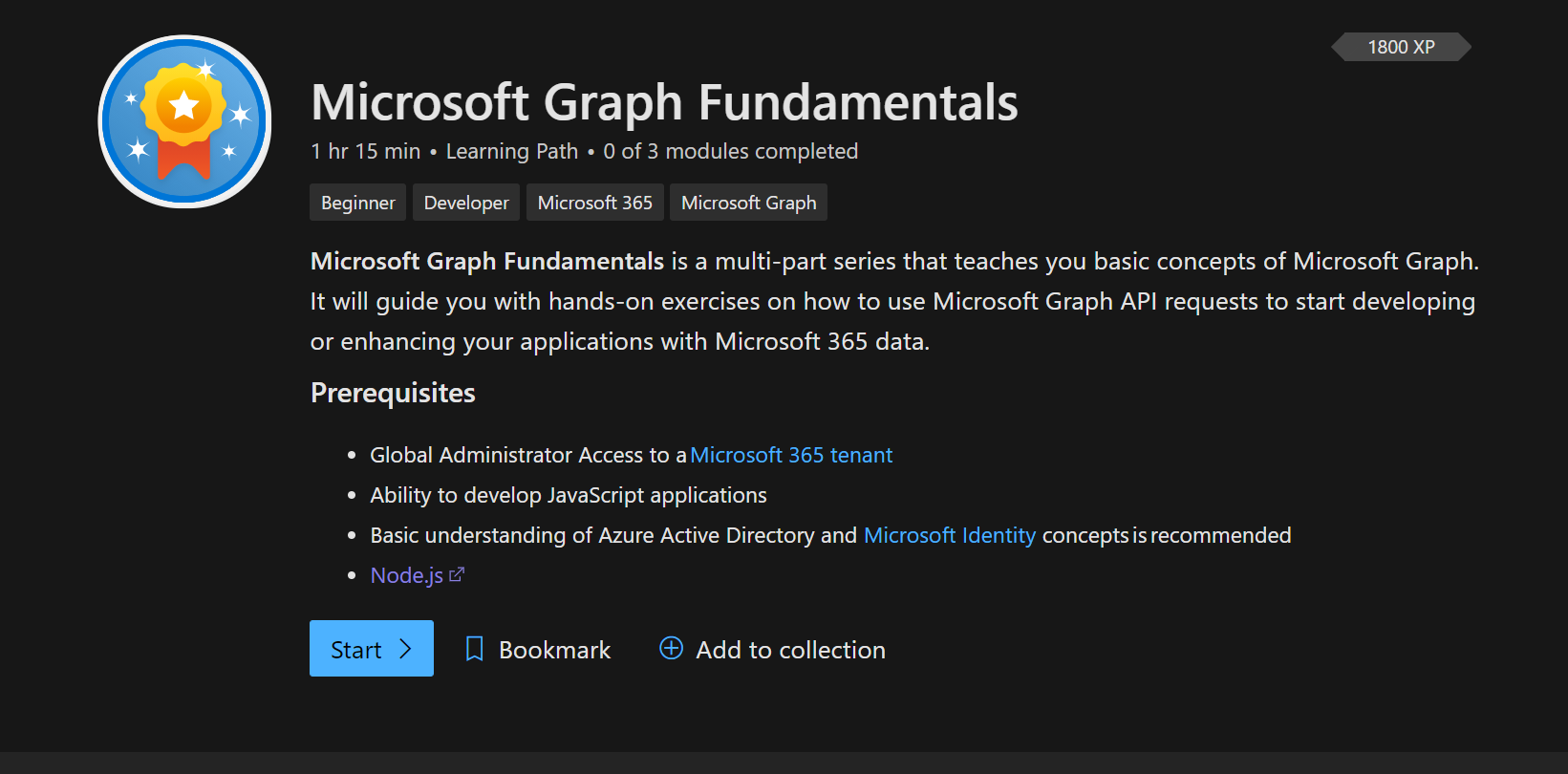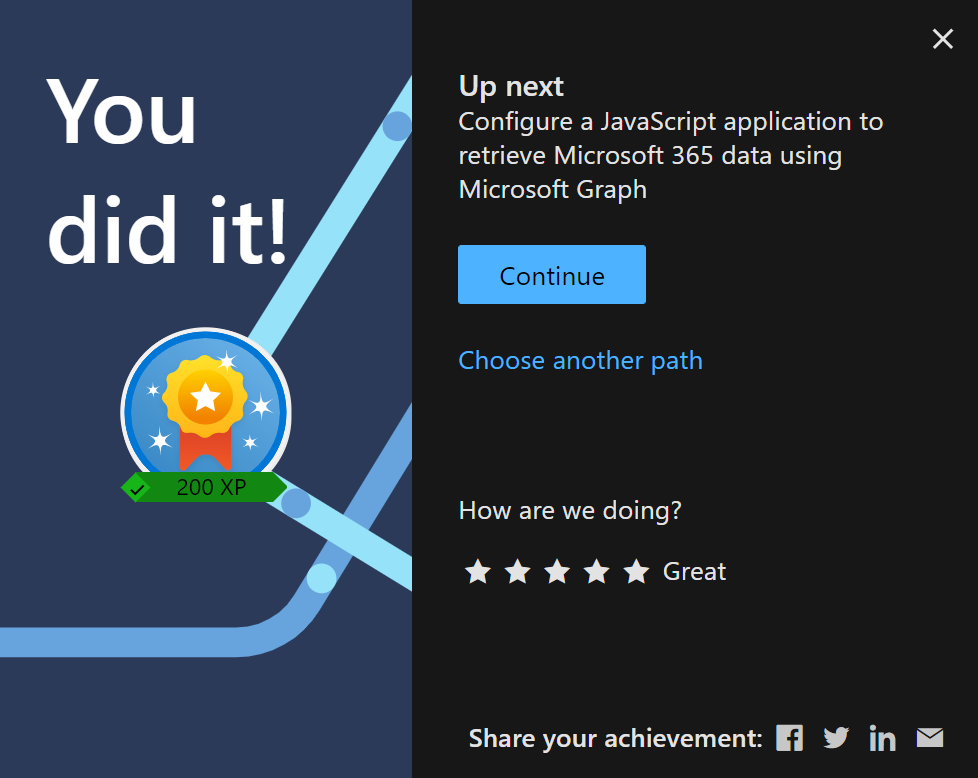Microsoft Graph Fundamentals learning path - Module 1
Doing Microsoft Graph Fundamentals learning path on MS Learn - Part 1

This blog post will summarize how I did the brand new Microsoft Graph Fundamentals Learning path. Microsoft Graph Fundamentals consists of 3 modules:
What is Microsoft Graph - lets you understand the Graph services and shows you how you can access user information from Graph using their learning playground called Graph Explorer. You will do a short exercise on that as well.
Configure a JavaScript application to retrieve Microsoft 365 data using Microsoft Graph - lets you understand how app registration works in Azure AD with permissions for Microsoft Graph powered apps and closes with two exercises using MSAL - making authentication easy.
Access user photo information with Microsoft Graph - in this module, you continue with the application you built-in module 2 and learn how to retrieve a user photo and do an exercise about it.
The whole learning path is estimated to take us ~75 minutes. Let’s see how it goes :-)
To be very honest: I worked with Graph before - see my blog posts here: Microsoft Graph – M365 Princess - but it’s the first time I do this guided learning on Microsoft Learn. I will cover module 1 in this post and continue with module 2 and 3 in the following posts.
What is Microsoft Graph
In super short: Microsoft Graph is a set of APIs that lets you access data in Microsoft 365 and use it for custom coded and low code applications. With this, Microsoft Graph is your key to data. Here are three tremendous advantages of it:
- across all Microsoft services, you can use one endpoint https://graph.microsoft.com - which makes development straightforward as you don’t need to learn all the different APIs for mail and calendar and files and so on
- documentation is fantastic, and there is a ton of learning material - like this learning path or the upcoming Learn Together- Building apps with Microsoft Graph event
- you can try out Graph in Graph Explorer - if you like to read more about that, read my blog post on how to get started with Graph Explorer
- Microsoft Graph Toolkit (you will learn more about it later) makes authentication (my personal kryptonite) easy. It also provides you with ready-to-use components and reduces the time you need to develop.
Intro
For this module, you will need to be a global admin in a Microsoft 365 tenant. The easiest way to have this is to join the Microsoft 365 developer program and get a free E5 subscription. If you are not familiar with this, read Julie Turner’s article about it, at least some basic JavaScript understanding, and you should know what Azure Active Directory does. You will also need to have Node.js installed.
The learning module introduces you to a business scenario so that it is easier for you to imagine which kind of applications we are talking about. In this scenario, we want to bring together messages from chat, emails, attended meetings, notes, key contacts, and relevant files.
Our application could also grow later on and bring in data from more services like Windows 10 services or Enterprise Mobility and Security Services. We will not build this in total in this learning path, but we get a perspective, what we can develop based on our organization’s needs.
Understand Microsoft Graph Services
At the very heart of Graph, we will find users and groups. In our application, we will need to access data from a single user’s personal scope (mail, messages, events) and a group scope (teamwork).
The module introduces you to some Microsoft Graph API calls and shows you how the response will look. All API responses will be in JSON format - in case you want to learn more about it, read this article by Bob German on Introduction to JSON
The even more exciting part is that apart from making direct API calls, Microsoft provides us with the Graph SDK (Software Developer Kit). We can use the client Graph SDK client libraries to even more easily call the Graph API.
Access user information from Microsoft Graph using Graph Explorer
This chapter introduces you to Graph Explorer -easily access it at aka.ms/ge, try out some sample queries! My blog post on how to get started with Graph Explorer explains that in detail.
Exercise - Access user information from Microsoft Graph using Graph Explorer
Time to access your own data! I strongly recommend not playing in your production tenant- especially if you do not only want to read data with GET requests but also want to write, update, or delete data with POST, PATCH, UPDATE, or DELETE requests. Get yourself a Microsoft 365 developer tenant and use this.
This chapter teaches you how to modify permissions in Graph explorer and how tips help you.
You will learn how to send a message to Teams via Graph - this is not a test; it will really appear in Teams. 🚀
Let us 1’up this already fantastic experience. Besides using this beautiful UI, Graph Explorer provides you with:
- Access tokens used for authentication (recognizing who a user is) and authorization (looking up the correct privileges)
- Code snippets for three different languages so that you can copy-paste them into your applications
- Microsoft Graph Toolkit components - most fabulous thing ever! If you are not familiar with MGT, go check it out
- Adaptive cards snippets so you can quickly build UI components for your apps
You see, this is the ‘absolutely carefree package’ provided by the Microsoft Graph team.
Conclusion on Module 1:
Microsoft Graph is not only THE door opener to access all kinds of information and data across Microsoft 365 for developers and makers. They also provide us with this fantastic learning playground, aka Graph Explorer, in which we can try out, learn, explore and get snippets for all kinds of development scenarios.
After introducing you to some basic concepts on Microsoft Graph, you have learned on a real-world example how to use Microsoft Graph before continuing to access data via Graph in a JavaScript application. This learning module is fantastic! If you never heard about Graph, you’ll get everything you need to start right away with it!

You May Also Like
How to get started with Graph Explorer
How to get started with Graph Explorer Don’t know what the Microsoft Graph Explorer is? Or have you already heard about it, but were not sure, how to get started and how this would help you? …
5 commands to try in CLI for Microsoft 365 to fall in love with it
5 commands to try in CLI for Microsoft 365 to fall in love with it After I blogged about How to send Adaptive Cards with CLI for Microsoft 365 and also used CLI to compare different ways to create …
How to create a (faux) table in Adaptive Cards with Power Automate
How to create a table in Adaptive Cards with Power Automate In this blog post we learn how we can display a table in an Adaptive Card, pull data from a SharePoint list and use Power Automate to do …





